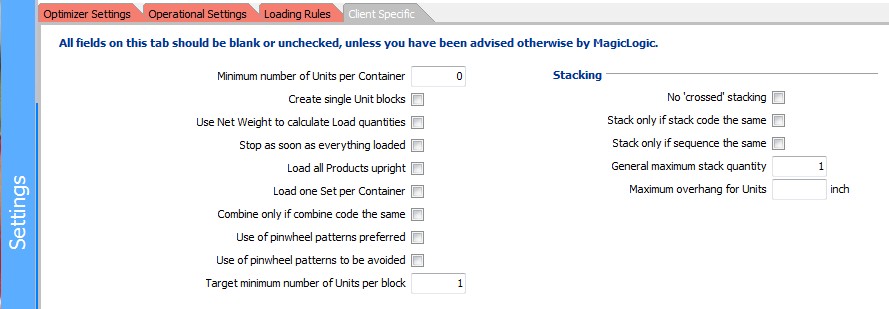Client specific Settings
Click on the main Settings tab, or press F7.
Then click on the Client Specific tab. You may have to make this tab visible first in the Options window.

Some features of Cube-IQ have been added at specific request of clients. On this tab you can control such features. As a general rule, all fields on this tab should be blank or unchecked, unless you have been instructed otherwise by MagicLogic.
Minimum number of units per Container - this setting is useful for two-stage loading, for example boxes on pallets, and next pallets into a truck. If the value here is (say) 2, there is no point in putting just these two units on a pallet, as they may as well be loaded separately into the truck.
Create single unit blocks - If checked, Cube-IQ will split all blocks into single unit blocks during its output phase. This is useful for example when feeding the results into a conveyor belt sequence.
Use Net Weight to calculate Load quantities - When building a Load you have the option to let the system calculate the quantities from a 'total weight to be loaded'. Normally this calculation uses the weight of the product, but some clients prefer to use its net weight.
Stop as soon as everything is loaded - check this if you only want to know whether a certain Load fits in a single Container and if quickly determining 'fit' is really important. The optimization will stop as soon as all units are loaded, and will not attempt to find a better (= easier) loading.
Load all products upright - is for cases where Products can be loaded in Containers in any orientation, but if the same Products are loaded on a pallet, they have to be upright. This avoids the need to keep changing Product data.
Load one set per Container - client special
Combine only if combine codes the same - client special to set a special loading scenario, without having to fill in a complete combination matrix.
Use of pinwheel patterns preferred - use of pinwheel patterns (loading four boxes into a long, wide, long, wide 'circle') will get some priority during the optimization.
Use of pinwheel patterns to be avoided - pinwheel patterns will not get loaded.
Target minimum number of units per block - A value of 1 will give standard loading results. In cases with many units, values like 4, 6 or even 12 will give a more regular loading. This avoids the operationally undesirable loading of very small blocks of units into small spaces to obtain a higher space utilization. Each loaded block of units will contain at least this number of units (if still available). If less units are still to be loaded than this Settings, smaller blocks will be created.
Stacking
No 'crossed' stacking - Cube-IQ will try to avoid loading a Product that is longer than wide on top of a Product that is wider than long, and vice versa.
Stack only if stack code the same - Cube-IQ will only stack Products with the same Stack Code.
Stack only if sequence the same - Cube-IQ will only stack Products if they have the same sequence number in the Load List.
General maximum stacking quantity - Cube-IQ will never stack more boxes than this setting.
Load in single stack only - In each Container (typically a box), Cube-IQ will create only a single pile of units. (Used for packing carpets in cartons.)
Robotics
Cube-IQ can be used to optimize Mixed Pallet loading, using robots. These two settings determine at which point the true approach to the placement point starts.